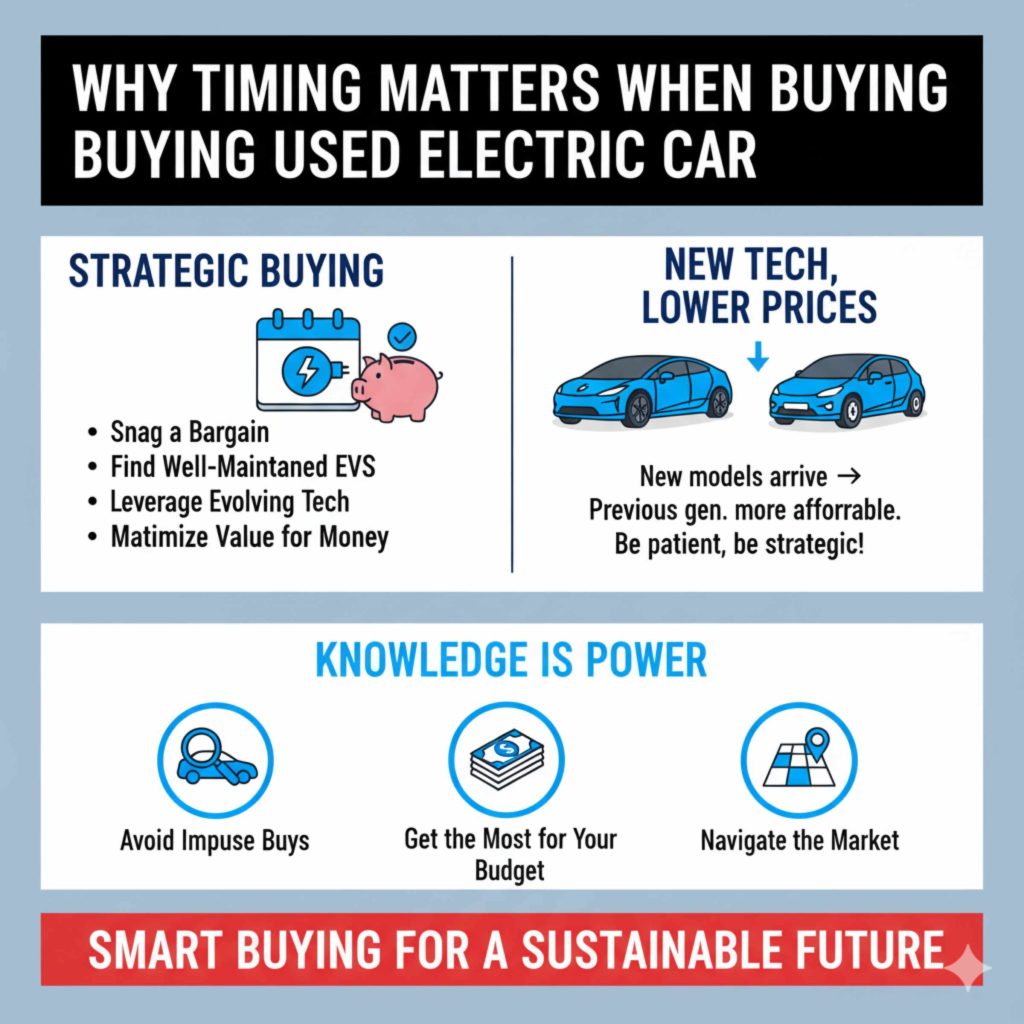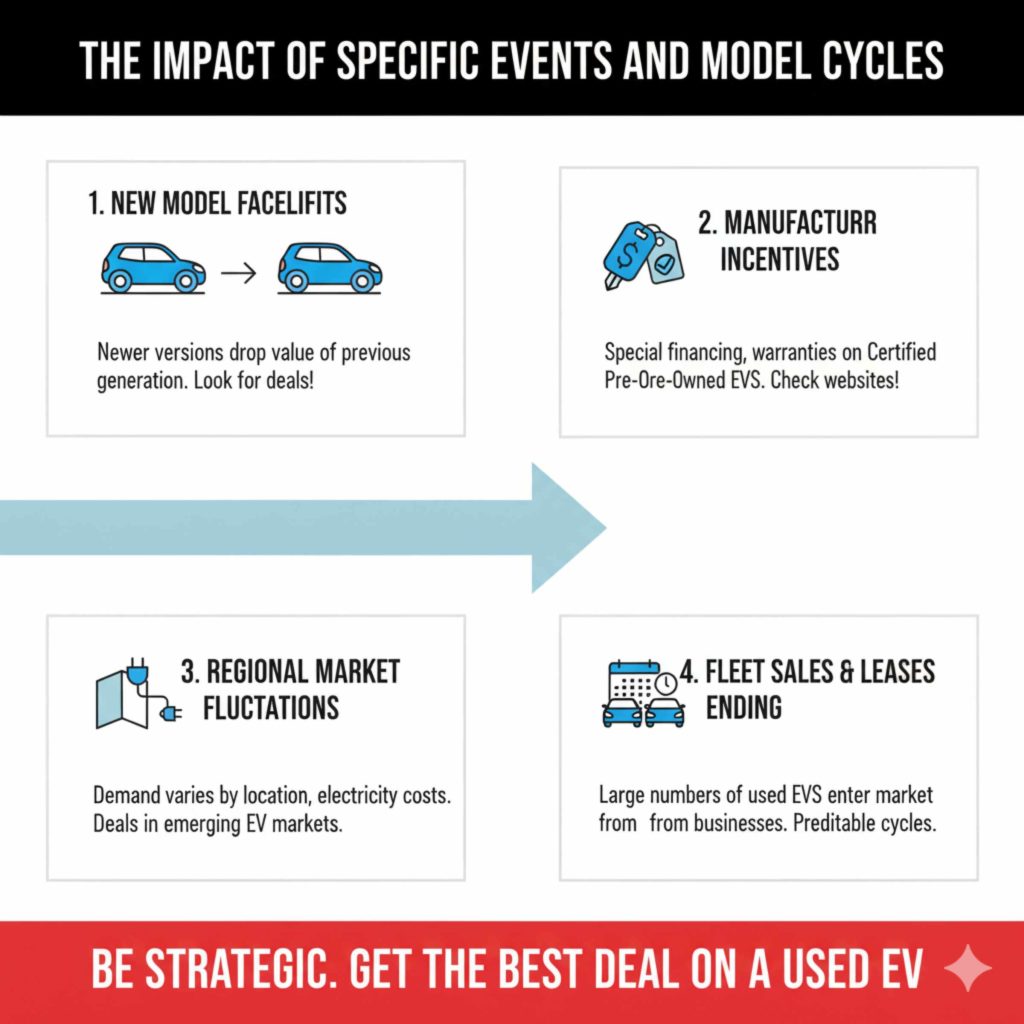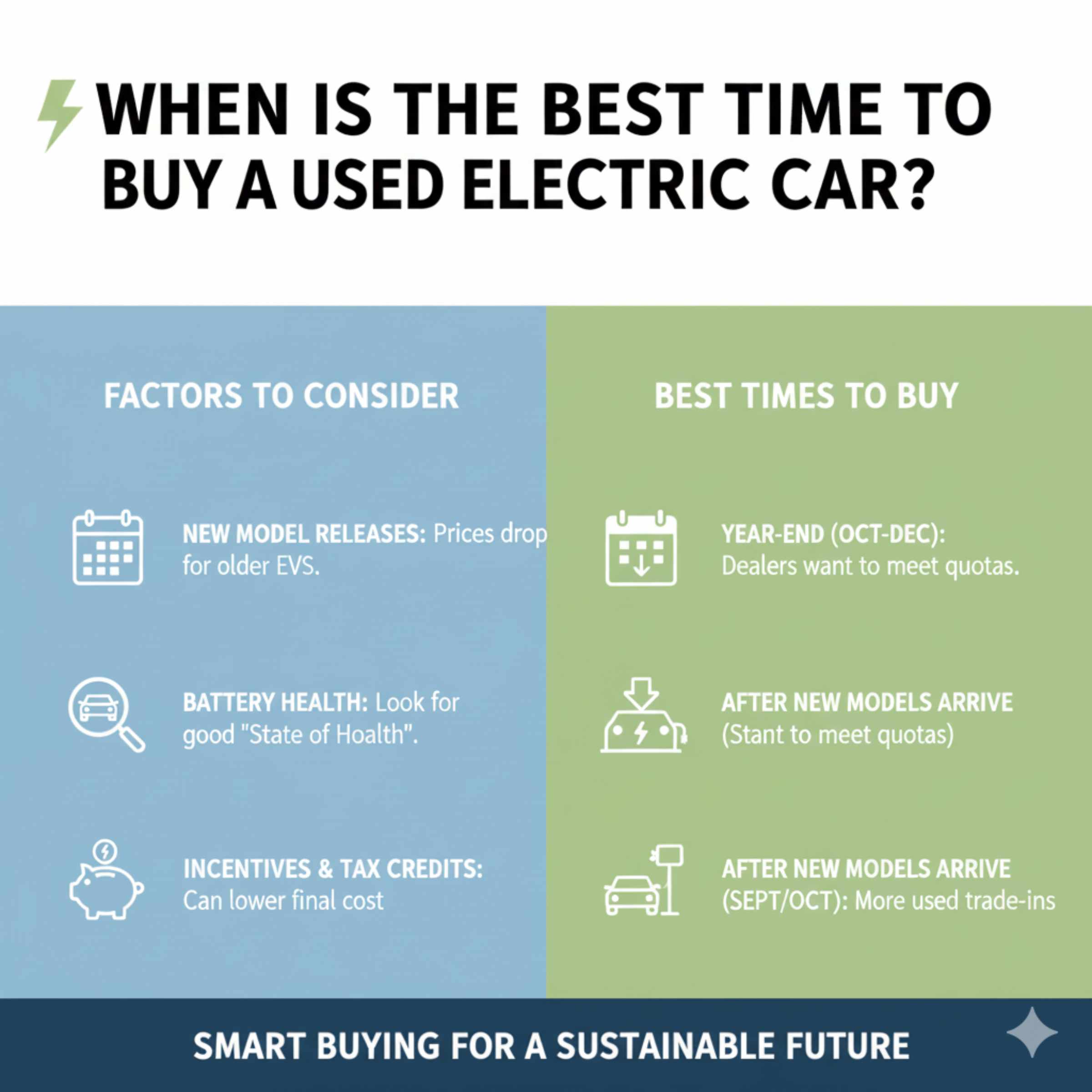Quick Summary: The best time to buy a used electric car is typically at the end of the year (October-December) for potential holiday deals, or in late summer (August-September) as new models arrive and dealers clear old inventory. Keep an eye out for tax credit eligibility and manufacturer incentives that can lower prices year-round.
Thinking about switching to electric without the brand-new price tag? That’s smart! Used electric cars are becoming a fantastic option for saving money and helping the planet. But just like any car purchase, timing can make a big difference in the deal you get. It can feel a little tricky figuring out when prices are at their lowest or when the best selection is available. Don’t worry, I’m here to break it down for you! We’ll explore the different times of the year that might offer the best savings and most choices, so you can feel confident you’re making a savvy electric car decision. Let’s get you rolling into a great deal!
Why Timing Matters When Buying a Used Electric Car
So, why fuss over the specifics of when to buy a used electric car? It’s not just about snagging a bargain; it’s also about finding a vehicle that has been well-maintained and has plenty of life left. Like any product with evolving technology, electric cars are influenced by new model releases, market demand, and seasonal sales cycles. Understanding these factors can help you position yourself for a win-win situation – getting a great electric car at a price that makes sense for your budget.
Think of it like this: new phone models come out, and suddenly the previous generation becomes more affordable. The same principle often applies to cars, especially with the rapid advancements in electric vehicle (EV) technology. By knowing the best times, you can be patient and strategic, avoiding impulse buys and ensuring you get the most value for your money. This guide will help you navigate the calendar and the market to find that perfect pre-owned EV.

Understanding the Used EV Market: Key Factors
Before we dive into the best times, let’s briefly touch upon what influences the used EV market. It’s a bit different from the traditional gas car market due to the specific nature of electric vehicles.
- Battery Health: This is crucial for EVs. While batteries are designed to last, their capacity can degrade over time and with use. Understanding battery health indicators is key. Resources like fueleconomy.gov offer insights into EV usability and efficiency, which indirectly relates to battery longevity.
- New Model Releases: When new EV models hit the market, often with improved range, faster charging, and newer tech, the demand for slightly older, used models can shift. This creates opportunities for buyers looking for value.
- Government Incentives: While often associated with new EVs, some used EVs may also qualify for incentives, especially if they meet certain age or price criteria. These can fluctuate and impact overall cost.
- Manufacturer Promotions: Sometimes, manufacturers offer special deals or certifications on their used EVs, making them more attractive.
- Lease Returns: Many used EVs are former lease vehicles. These are often well-maintained and have lower mileage, making them desirable. The timing of lease returns can influence availability.
The Calendar Game: When Prices & Inventory Tend to Be Best
Like many industries, the automotive world has its cycles. For used electric cars, certain times of the year often present better opportunities for buyers. Let’s break down the calendar:
End of the Year (October – December)
This is often a prime time for deals, and not just for EVs. Dealers and manufacturers are eager to meet sales quotas and clear out their inventory before the new year begins. This push can translate into lower prices on used vehicles across the board.
- Sales Quotas: Salespeople and dealerships often have annual targets to hit. The end of the year is a critical period for them to make those numbers, leading to increased willingness to negotiate.
- Holiday Promotions: Many dealerships offer special holiday sales events. While these might focus on new cars, used car departments often participate with attractive pricing.
- Clearing Inventory: As new model year vehicles become more prominent, dealers want to make space on their lots. Older used inventory, including EVs, can become more negotiable to make room.
- Tax Considerations: Some buyers might be looking to make a purchase before the end of the tax year for potential write-offs or to take advantage of any expiring incentives. This can create buyer urgency that dealers might capitalize on, but it also means more buyers are active, potentially driving up demand. However, the overall pressure to clear stock often outweighs this.
Late Summer (August – September)
This period often signals the arrival of new car models for the upcoming year. As these fresh vehicles roll into dealerships, the older inventory, including used EVs, needs to be moved. This can lead to some excellent opportunities.
- New Model Year Arrival: Dealerships receive their shipments of new model year cars, often starting in late summer. This means they need to sell off previous year stock, which can include both new and used vehicles.
- Clearing Out Older Trades: When customers trade in their old cars for new ones, dealers need to sell these trade-ins. If a lot of newer EVs were traded in for the latest models, you might find a good selection of recent, used EVs at this time.
- Pre-Holiday Slowdown: Sometimes, there’s a slight lull in buyer activity as people prepare for back-to-school, before the end-of-year holiday rush begins. This can give buyers a slight edge in negotiations.
Mid-Spring (April – May)
As tax season wraps up, you might see a surge of people ready to spend their refunds on a new (or new-to-them) car. This increased buyer activity can sometimes lead to more inventory coming onto the used market as people trade in their current vehicles.
- Tax Refund Spending: Many people use their tax refunds for significant purchases like cars. This can increase demand and also bring more trade-ins to dealerships.
- Seasonal Car Buying: Spring is traditionally a popular time for car shopping. Warmer weather makes test drives more pleasant, and people often tie car purchases to spring cleaning or a fresh start.
- Inventory Refresh: Dealerships might be looking to refresh their used car inventory after the winter months.
Less Ideal Times to Buy (and Why)
While the above times can be great, there are periods when you might find fewer deals or less optimal choices.
- Early Summer (June – July): This can be a busy buying season, especially with graduation and summer vacations. Demand might be higher, and dealers may be less inclined to offer deep discounts.
- Early Spring (February – March): While tax refunds start coming in, the initial rush might not result in the most aggressive pricing immediately. It takes time for inventory to build up from trades.
- Holiday Weekends (Specific): While the end of the year is good, specific, short holiday sales (like Memorial Day or Labor Day) can attract a lot of buyers, sometimes leading to quick sales and less room for negotiation on the best models.
Smart Strategies for Buying Used EVs Anytime
Regardless of the time of year, there are always smart ways to approach buying a used electric car. These tips will help you secure a great deal and a reliable vehicle whenever you decide to buy.
1. Research Battery Health and Range
This is paramount for EVs. Understand that battery capacity naturally degrades over time. Look for vehicles with certified pre-owned (CPO) programs that often include a battery health guarantee. Research the original EPA-estimated range and compare it to the current condition. Factors like charging habits and climate can affect battery life. Websites like Energy.gov’s EV technology section can offer general insights into battery performance over time.
2. Check for Availability of Charging Infrastructure
Before you buy, ensure you have access to charging. This might mean installing a home charger or checking the availability of public charging stations in your area. Resources like the Alternative Fuels Data Center (AFDC) from the U.S. Department of Energy can help you map out charging locations.
3. Look for Certified Pre-Owned (CPO) EVs
Many manufacturers offer CPO programs for their used EVs. These vehicles undergo thorough inspections and come with extended warranties, often including the battery. This provides extra peace of mind.
4. Understand Any Remaining Battery Warranty
EV batteries typically come with long warranties (often 8 years or 100,000 miles, whichever comes first). Check how much, if any, of this warranty is left on the used EV you’re considering. This is a significant factor in your long-term ownership costs.
5. Be Aware of Incentives for Used EVs
Federal and state incentives can apply to used EVs, often for vehicles purchased from dealerships that meet certain price and age requirements. These can significantly lower your out-of-pocket cost. For example, the IRS provides tax credits for eligible used clean vehicles. Always check the latest details on IRS.gov as rules can change.
6. Negotiate Wisely
Just like with any car purchase, be prepared to negotiate. Know the market value of the specific make and model you’re interested in, considering its age, mileage, battery health, and any features. Use online resources like Kelley Blue Book or Edmunds to get a baseline price.
7. Test Drive Thoroughly
Pay attention to how the car accelerates, brakes, and handles. Listen for any unusual noises. For EVs, check that the infotainment system, climate control, and all electronic features are working correctly. Ensure the charging port opens and closes smoothly.
Comparing Timing Strategies: A Quick Look
To help you visualize when you might get the best bang for your buck, here’s a table comparing the general trends:
| Time of Year | Potential Pros (Used EV Buying) | Potential Cons (Used EV Buying) |
|---|---|---|
| October – December |
|
|
| August – September |
|
|
| April – May |
|
|
| June – July |
|
|
The Impact of Specific Events and Model Cycles
Beyond the general calendar, several other factors can influence when you might find a great deal on a used electric car.
1. New Model Facelifts and Redesigns
When a major automaker releases a significantly updated version of an EV model, the previous generation often sees a dip in value. This is especially true if the new version offers notable improvements in range, charging speed, or technology. Buyers looking for a deal can often find excellent prices on the outgoing models once the new ones start arriving in showrooms.
2. Manufacturer Incentives on Used EVs
Keep an eye on manufacturer websites and dealership promotions. Sometimes, car brands will run specific campaigns for their certified pre-owned electric vehicles, offering low financing rates or extended warranties. These promotions can occur at any time of the year and can significantly sweeten the deal.
3. Regional Market Fluctuations
Demand for EVs can vary by region, influenced by factors like local electricity costs, government mandates, and public charging infrastructure availability. In areas with strong EV adoption, used EV prices might remain more stable. In emerging EV markets, you might find more eager sellers and potentially better deals as people upgrade.
4. Fleet Sales and Leases Ending
Many EVs are purchased by businesses or rental car companies for their fleets. When these leases or contracts end, a large number of relatively new, low-mileage EVs can enter the used car market. This often happens in predictable cycles, and knowing when these fleet vehicles are typically released can give you an advantage.

Frequently Asked Questions (FAQs)
Q1: Will I be able to find a good used electric car with decent battery life?
A1: Absolutely! Most EV batteries are designed for longevity, and many used EVs still have a significant portion of their original battery warranty remaining. It’s crucial to research the specific model’s battery health and warranty terms before buying.
Q2: Can I get a tax credit for buying a used electric car?
A2: Yes, under certain conditions. The federal government offers a tax credit for eligible used clean vehicles. The vehicle must be purchased from a dealer, cost less than $25,000, and meet specific age and battery capacity requirements. Always check the latest IRS guidelines on IRS.gov.
Q3: Are used electric cars more expensive to maintain than gas cars?
A3: Generally, used EVs tend to have lower maintenance costs. They have fewer moving parts than gasoline cars (no oil changes, fewer brake replacements due to regenerative braking). However, potential battery repair or replacement down the line is a factor to consider, although warranties often cover this for many years.
Q4: How important is it to buy a used EV from a dealership versus a private seller?
A4: Buying from a reputable dealer often provides more security. They typically perform inspections, offer warranties, and handle paperwork efficiently. Dealerships are also crucial for accessing CPO programs and potentially qualifying for used EV tax credits. Private sales might offer lower prices but come with less recourse if issues arise.
Q5: What is “range anxiety,” and how does it affect the price of used EVs?
A5: “Range anxiety” is the fear that an EV has insufficient range to reach its destination. As EV technology improves and battery capacity increases, this concern is diminishing. However, on older used models with less range, this fear can sometimes lead to lower prices compared to newer EVs with greater range capabilities.
Q6: Are there specific EV models that hold their value better?
A6: Models from Tesla, for example, have historically shown strong value retention due to brand demand and performance. Similarly, popular models from manufacturers like Nissan (Leaf) and Chevrolet (Bolt) can also be good bets. Researching individual model depreciation trends is always a good idea.
Conclusion
Navigating the timing for buying a used electric car doesn’t have to be a guessing game. By understanding the ebb and flow of the market – from seasonal sales cycles influenced by quotas and inventory turnover to the impact of new model releases and incentives – you can significantly increase your chances of finding a fantastic deal. While the end of the year (October-December) and late summer (August-September) often present the most opportune moments for aggressive pricing and broader selection, smart strategies can yield great results anytime. Always remember to prioritize research, especially concerning battery health and remaining warranties, and take advantage of available tax credits and certifications. With a little patience and this guide, you’re well-equipped to drive away in a used EV that’s perfect for your needs and your wallet. Happy hunting!

